I saw a post recently that claimed Gwyneth Paltrow’s return to acting “after 20+ years” is “a sign that the influencing business is over.” The poster’s implication, seen in her replies, is that an industry centered around hawking overpriced garbage is no longer realistic because the economy is so bad. She cites sources that indicate “wellness” culture might be falling out of fashion, and that Paltrow’s Goop might be holding on by a thread. That might be true—I haven’t heard about Goop lately, and I do think vegan-ness and Gua Shas have been temporarily replaced by Crumbl Cookies, in terms of what people are interested in—but I always find it pertinent to review how money works, which this poster seemingly does not understand.
Gwyneth Paltrow was never an influencer; she is a grifter, probably and reportedly worth hundreds of millions of dollars. Her ex-husband, with whom she shares a child and seems friendly with, is probably and reportedly worth about the same. If she ever wanted another check from Marvel, I have confidence they would hungrily invite her back. She could sell Goop if it’s no longer growing or it’s too much work, and never work in any industry ever again. But, when her Marvel tenure ended and Goop began, it gave Gwyneth Paltrow the most exposure she had had in many years. She had a Netflix show, was covering magazines, and her gimmick vagina candles and chocolate melatonin were top of everyone’s mind. Six years after that peak, Goop and its associated trends are out of everyone’s consciousness, and by extension so is Gwyneth Paltrow. I don’t think she’s returning to acting because she needs whatever dollars and cents they shelled on for Marty Supreme; she feels a need to grift her way back into the public eye.
That’s fine: I like Gwyneth Paltrow, and if you’re not a grifter in today’s world neither your spirit or livelihood will survive. But the misunderstandings embedded in those tweets weirdly remind me of Lady Gaga’s current project and the way people are reacting to it, too. As I’ve already written, people have been behaving as though Gaga is returning to some more personally genuine aesthetic and sound she hasn’t used since her debut albums. I get where this is coming from, as Catholic citations and talk-singing were marquee devices of the Born this Way era, but I think Chromatica, and even Joanne, were more classically Gaga—more The Fame, “Speechless,” Jo Calderone—than MAYHEM is. And, while she is purposefully “returning” to certain aesthetics for attention after the sort-of failures of Joanne and Chromatica, it’s not because she’s achieved inner peace or has been “lost” since ARTPOP or Born this Way, just now suddenly finding returning to her truth as an artist. After a decade of creating new characters and aesthetics that were rejected by fans, she is doing what a loud minority have been clamoring for since 2012: repeating the same stuff she did once that they liked, rather than evolving.1
Influencer culture and Lady Gaga converged this weekend at Coachella. Once the most important event of the year for influencers of all kinds, each night came and went without any real photos of pseudo-celebrities all dressed up in the desert. While this seems to corroborate claims that influencing “over,” the influencers were there, a new age of low-level celebrities—characters like Emma Chamberlain replacing former regulars like Vanessa Hudgens—just without any real pomp and circumstance: more like any 2023 Eras Tour show rather than an annual extravaganza.
Gaga headlined Friday, her set structured around TikTok-viral tracks from The Fame and Born This Way: it opened with “Bloody Mary,” “Abracadabra,” and “Judas,” then dredged up “Scheiße” and “Alejandro.” It was the first Gaga set in 17 years (supposedly) that didn’t feature “Just Dance,” and the only major, pre-MAYHEM singles besides “Judas” were “Poker Face,” “Born This Way,” and “Bad Romance”: no Artpop, Joanne, OR Chromatica. While she played Coachella not so long ago, the festival is supposed to be a career-defining performance. But choosing the handful of songs championed by “fans” who claim to hate half your discography patronizing and lazy. It was a good performance, but ultimately a performance for a Vegas residency or a stadium tour, not Coachella. The lesson: Gaga, like Paltrow, is not “returning to her roots” or “trying to make money” so much as she is grifting her way to internet friendliness, and Coachella no longer means much at all.
There is another lesson to be learned here, about who Coachella is “for” and about the difference between online and real life. As out-of-touch and boring as I find Renaissance and Cowboy Carter, “Beychella” is one of the greatest pop performances of all time, and I think the festival’s peak, in terms of cultural relevance. It’s distinctive and lively, sustaining a sense of liveness by minimizing the bells and whistles one would expect from a residency or tour. I also think one of the things that works best at Coachella (and the Super Bowl) is bringing guests—Harry Styles and Shania, Lana and Billie—and Beyoncé reunited Destiny’s Child and herself with her sister. She could never do either again post-Coachella and Super Bowl—we get it—but I don’t understand what Gaga’s aversion is to sharing stages. I think she could have gotten Beyoncé for the first-ever live performance of “Telephone,” or at least have called upon Bruno Mars to do their money-printing song. If she asked, Taylor Swift might have come for “How Bad Do U Want Me!” But the total lack of surprise in her 2025 set, all to make room for the patronizing, clouded-by-TikTok fanfare of bringing stuff like “Bloody Mary” “back” is demonstrative of Coachella’s dwindling ability to create moments that are exciting outside X.com—Lana Del Rey is perhaps the most internet-friendly and reliant pop stars of all time, and even she brought 2 guests.2
Saturday, Charli xcx took the Mainstage before Green Day headlined, which I find a little silly. It reminds me of how confused I am that the Glastonbury headliners are The 1975, Neil Young, and Olivia Rodrigo: now we’ve really lost our minds. I love The 1975, but they shouldn’t be headlining anything, and Olivia Rodrigo might have way more commercial grit than Charli, who is second-billed at Glastonbury, but she’s not any more famous. The only reasons Rodrigo has hits is because she’s American and 22. If Charli had put her boobs away and gotten in with, like, Cirkut sooner, had been friendlier to Taylor Swift, Crash would have made her as huge as British women can get. Now, at Glastonbury, she’s suppressed to the same tier as Raye and Doechii, who both seemingly came into existence within the last 6 months. At Coachella, Charli’s on the same tier as Megan Thee Stallion and Missy Elliott, two other people who I think could probably headline either festival.3
Twitter blows Charli’s fame and commercial success way out of proportion, but Coachella isn’t Billboard, and Twitter is exactly who they’re trying to appeal to. It’s also who the music industry, broadly, has their sights on, if Gaga’s exploitation of herself from 15 years ago is any indication.4 I also understand that each night should have a generically and generationally different artist headline, which I think the mix of Gaga, Green Day, and Post Malone successfully achieves. A huge part of Coachella is appealing to annoying Gen X guys, which is why Blink 182 is seemingly playing every other year, and why Green Day is allowed to swing by and say F YOU to President Trump.5 But last year there was none of that: the headliners were Lana, Tyler, and Doja. There is some major miscalculating going on in the translation between phones and real life.

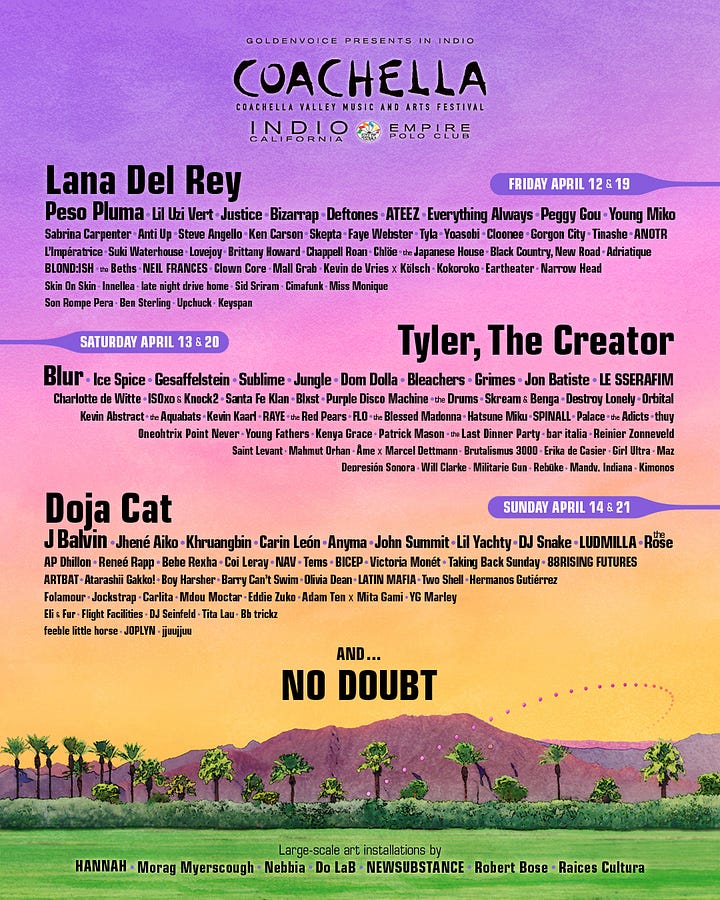
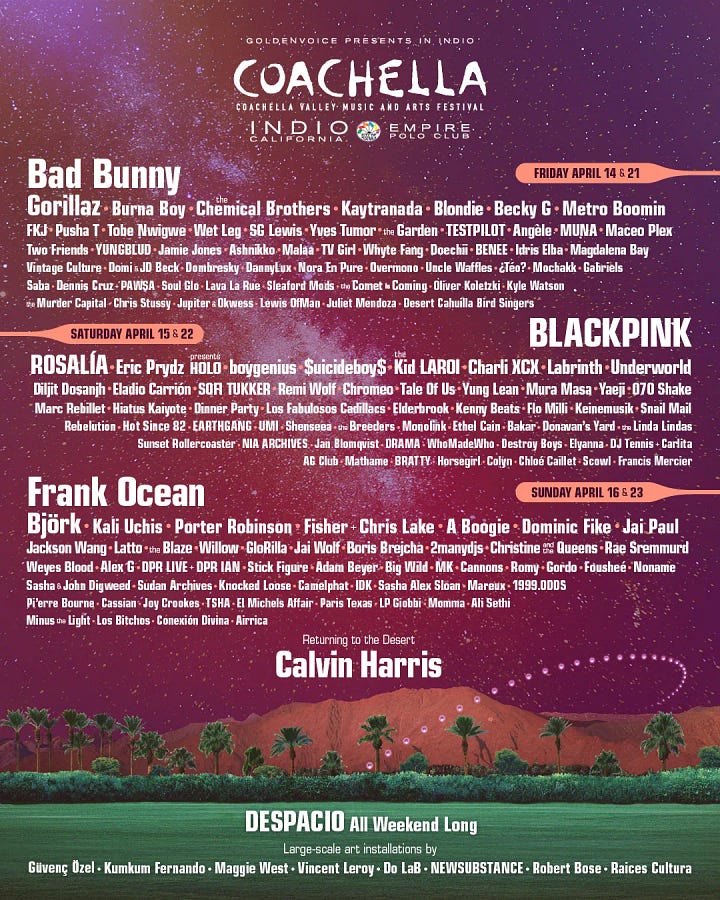
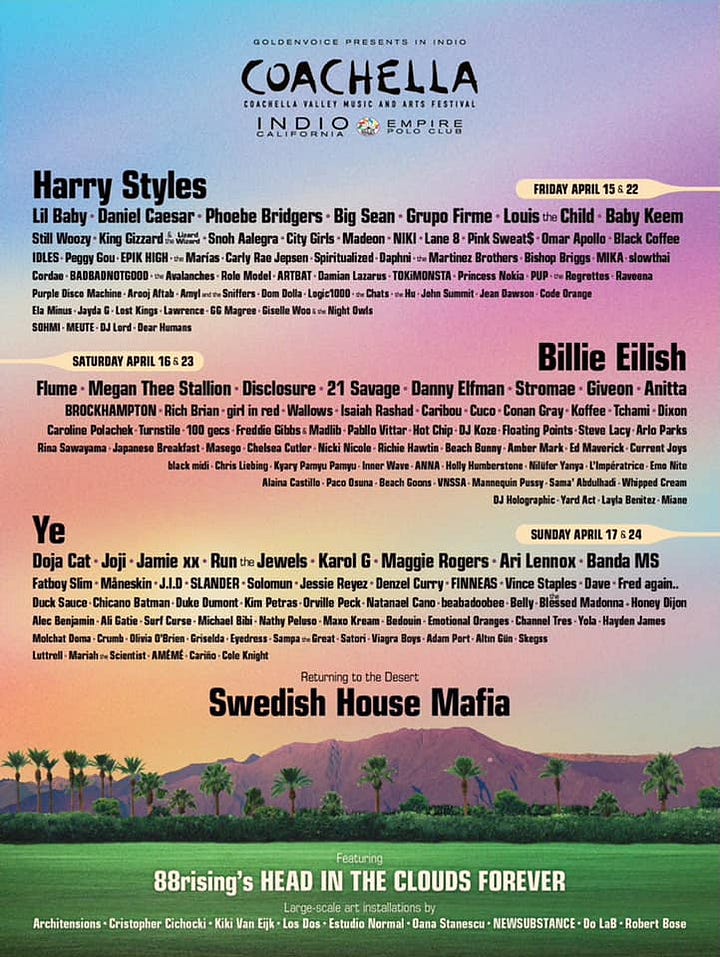
The year prior, headliners were Bad Bunny, BLACKPINK, and Frank Ocean, which—before or after Frank was haphazardly replaced by Blink 182—is a lot closer to Gaga, Green Day, and Post Malone, or 2022’s Harry Styles, Billie Eilish, and Kanye West (two huge pop stars to different markets, and one real artist with cult intrigue and popularity). But Lana, Tyler, and Doja are exactly the same amount of famous to the same kind of people,6 and only marginally more so—by the sheer amount of years that they’ve been around, in Lana and Tyler’s cases—than Charli or Megan Thee Stallion. Doja is only famous because of TikToks from 5 years ago, and I think any investment in her this far removed from Elvis is based on magical thinking. Below even Charli or Megan this year is BLACKPINK alumni and stars of The Idol and The White Lotus, JENNIE and LISA. I understand that Rosé is the most famous and successful solo BLACKPINK member, but you’re telling me the only other two I know by name are less famous than Megan Thee Stallion?7 I’ve certainly seen more TikToks about JENNIE and LISA in the last 2 years than I have about Doja Cat.
I don’t know a thing about how booking and billing works with musicians, and I suspect 90% of the reasoning boils down to timing and bureaucracy. But my point is that, with every year removed from COVID, these lists of artists mean less and less in terms of star power and what matters to a broader public—on which Coachella relies to stay relevant—or to the people who broadcast Coachella to that public: influencers.

Of course, Coachella ran as the American Glastonbury—a real, if not more immediately corporatized music festival—for many years before Instagram was invented. Before the app even took off, though, in 2012 Coachella transformed from a three-day concert to a two-weekend cultural event. This, coinciding with the quick growth of “posting” as the center of all fame, marketing, and leisure, made it less an amusement park than a status symbol, and a necessary one for certain personalities. In the spirit of Glastonbury and on the heels of The Bling Ring, one of those personalities was the party girl, now Victoria’s Secret Angels instead of Kate Moss, Vanessa Hudgens instead of Alexa Chung. The other personality, though—the influencer—evolved conditionally and concurrently with Coachella in the 2010s, helping to codify grifting as the standard cultural mode of the 2020s.
“Commentary” pieces about “our times” (Black Mirror, Kip Williams’ Dorian Gray) almost always use Instagram as the center of how we understand and use the Internet. It’s definitely what started it, transforming Facebook’s collegiate formality into something sexier and more personal, but Instagram has been increasingly irrelevant since TikTok’s explosion in 2019. While, 10 years ago, they were a mark of “realness,” posed, still images are now understood as overly-professionalized in contrast to more off-the-cuff and vulnerable short-form video. Funnily enough, though, the runway for this was long-form video, emerging around the same time as 2-weekend-Coachella and Instagram. The people who made Coachella what it is in a broader vernacular aren’t the artists or B-list celebrities that brought Glastonbury stateside, but the YouTubers who dressed up in cowboy hats and vlogged their Palm Springs AirBnBs.
My favorite influencer/vlogger, even last year wore what were essentially costumes. This year, she’s wearing jeans and looks like she’s going to dinner. She hasn’t posted long-form Coachella vlogs yet, but her TikToks have been far more subdued. For Byrdie this week, Emma Chamberlain reflected on her former, more costume-like Coachella looks as “never Coachella-friendly”: “they looked great for the event, [but] that era of my life is over… I don’t think I’m dressing up for Coachella anymore.” This all directly coincides with the casual-ness of short-form content, which demands more (faux) honesty than professionalized photoshoots at a music festival. A palpable decline in influencer interest and the festival’s marquee spectacle being Gaga “doing Born This Way again” seem to me signs that Coachella’s relevance, calculated by its ability to speak to and exploit influencer culture, is on its way out.
In 2022, Kylie Jenner and Kim Kardashian publicly asked Instagram to stop promoting reels and to “Make Instagram Instagram Again.” As plenty of people have pointed out, the Kardashians have never been able to adapt to the new short-form landscape, as their whole schtick is entirely dependent on controlling every molecule of their image. While something like Skims8 will always keep them in power, I think the lack of TikToks has legitimately eroded their social capital. A great example: the family, including Kourtney, whose most recent (solo) business endeavor is essentially Goop, just did a collaboration with Crumbl Cookies, which is popular only because of TikTok, a platform the Kardashians barely use. It wasn’t so long ago that the Kardashians were married into music royalty or at the Met, so you could read a Crumbl line as stooping for cash. They have money, though. What they don’t have so much of is a grasp on coolness.
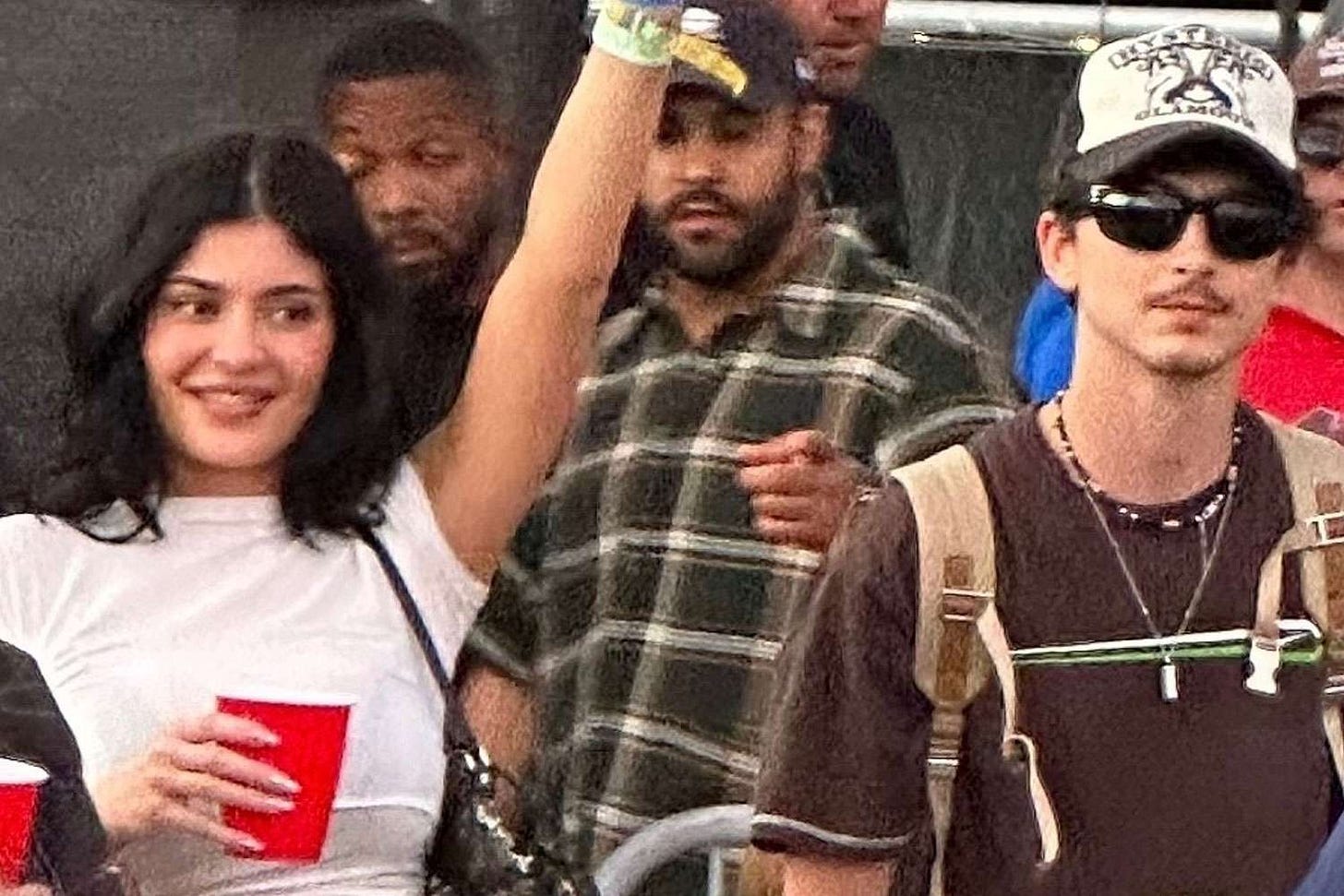
Like Gwyneth Paltrow’s pivot back toward Hollywood, it’s in this more Kardashian-sparse epoch that Kylie Jenner is dating a major movie star. Maybe Gwyneth, Kourtney, and Kylie would continue on the more internet-centric side of entertainment if they were up to short-form content and the vulnerable, dressed-down relatability it demands. They’re not, though, so to stay relevant they have to go back to what they know. I don’t know if this is a fissure or suture between Hollywood and internet celebrity; Kylie’s boyfriend is Gwyneth’s co-star, but Kylie was seemingly at Coachella to do the most influencer activity of all time, sell a product at a party. Regardless, though, I struggle to understand how things like Coachella will adapt to a mixing and matching of fame levels, an increasing soupiness between music, celebrity, and apps. My suggestion: call the whole thing off, and combine it with F-1. Have every rich person in every entertainment industry descend upon Vegas for the month of October every year, and don’t let any press in except vloggers wearing cowboy hats.
ICYMI I love MAYHEM. But I think it’s worse than Chromatica.
The other was Camila Cabello.
Missy Elliot not headlining is just racism, right?
See also an over-investment in “Djo,” Joe Keery’s music project, after “When I go back to Chicago, I feel it” virality (makes me lol every time). Also, keep in mind that one of Gaga’s most commercially huge projects was A Star Is Born, which coincided with “The Cure” and “Million Reasons” of the Joanne era. That album isn’t really a flop in anyone’s mind except Twitter’s and, because of that, Gaga’s.
I like Blink 182 and Green Day. But can we get Fall Out Boy to come and make this about Trump:
The ploy to Gen Xers that year was that, at the bottom of the lineup poster, it says “AND… NO DOUBT.”
I love this song:
I love Skims.




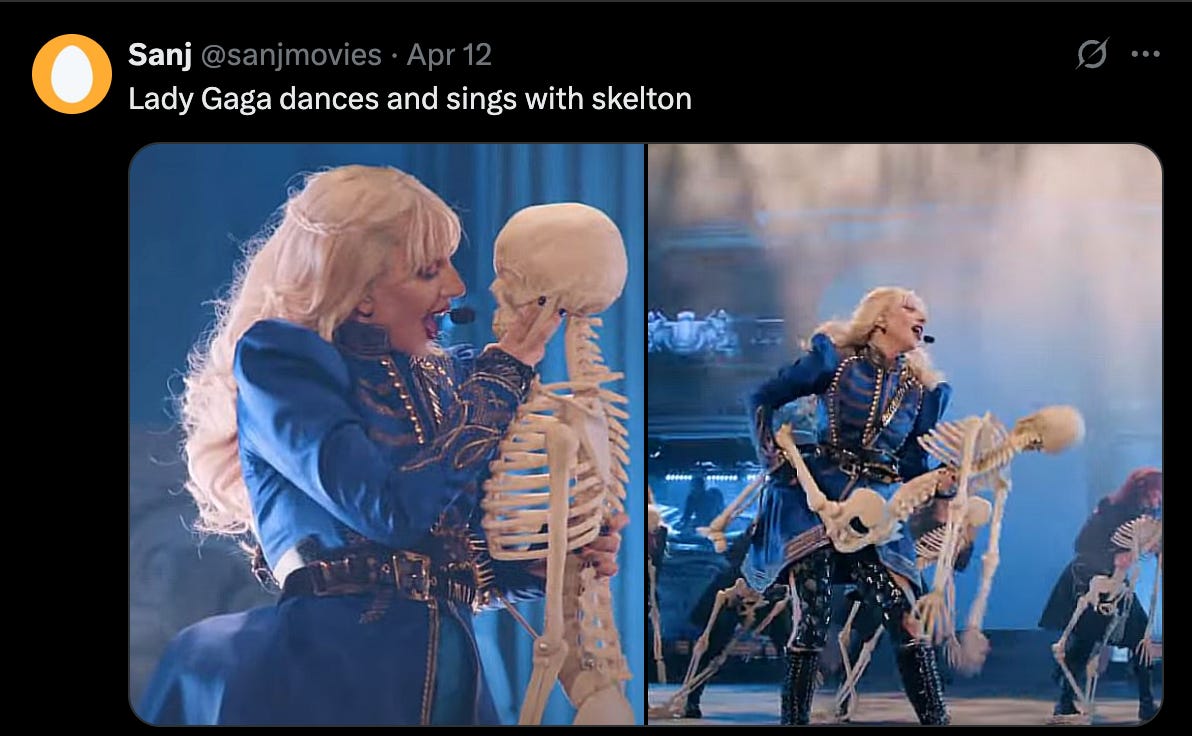
crazy to me that Missy Elliott was not billed as headliner and loved when she was a car that became a person on stage. I watched clips of Meg who I like much more as a celeb/cultural figure than I do her music - I feel like her output the last two years has been mostly irrelevant, not unlike Doja Cat I consider her an artist heavily reliant on TikTok/shortform who has since floundered a bit.
The Twitter about face on Charli is SO funny to me - is wearing a sash that says Miss Shoulda Been Headliner not literally what brat was about? to me this is mostly reflective of people being embarrassed that they were into this whole thing last year but not this year. Crash > brat, imho
I LOVE APT.!!!!!!!!! reminds me of Ting Tings :D
thank you for having actually nuanced cultural takes it's so astonishingly rare